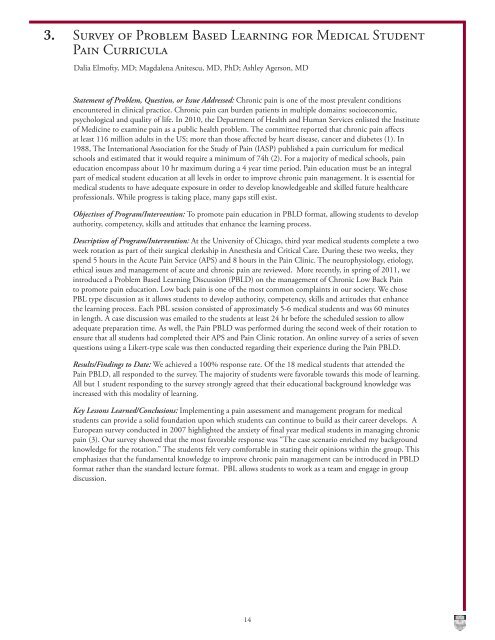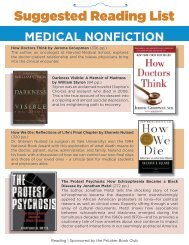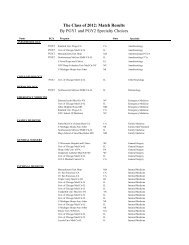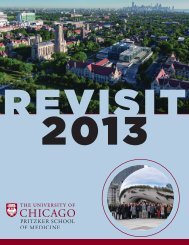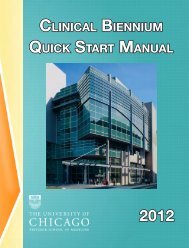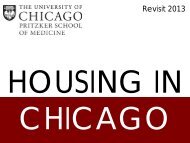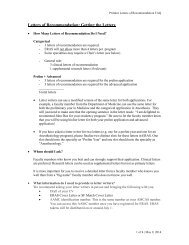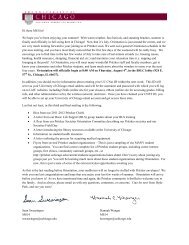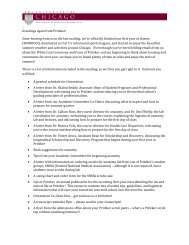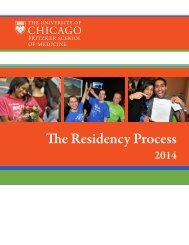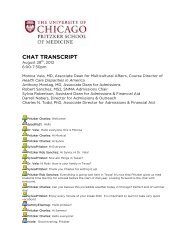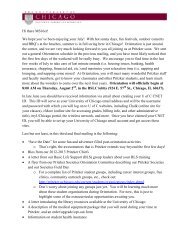Academy of Distinguished Medical Educators - Pritzker School of ...
Academy of Distinguished Medical Educators - Pritzker School of ...
Academy of Distinguished Medical Educators - Pritzker School of ...
You also want an ePaper? Increase the reach of your titles
YUMPU automatically turns print PDFs into web optimized ePapers that Google loves.
3. Survey <strong>of</strong> Problem Based Learning for <strong>Medical</strong> Student<br />
Pain Curricula<br />
Dalia Elm<strong>of</strong>ty, MD; Magdalena Anitescu, MD, PhD; Ashley Agerson, MD<br />
Statement <strong>of</strong> Problem, Question, or Issue Addressed: Chronic pain is one <strong>of</strong> the most prevalent conditions<br />
encountered in clinical practice. Chronic pain can burden patients in multiple domains: socioeconomic,<br />
psychological and quality <strong>of</strong> life. In 2010, the Department <strong>of</strong> Health and Human Services enlisted the Institute<br />
<strong>of</strong> Medicine to examine pain as a public health problem. The committee reported that chronic pain affects<br />
at least 116 million adults in the US; more than those affected by heart disease, cancer and diabetes (1). In<br />
1988, The International Association for the Study <strong>of</strong> Pain (IASP) published a pain curriculum for medical<br />
schools and estimated that it would require a minimum <strong>of</strong> 74h (2). For a majority <strong>of</strong> medical schools, pain<br />
education encompass about 10 hr maximum during a 4 year time period. Pain education must be an integral<br />
part <strong>of</strong> medical student education at all levels in order to improve chronic pain management. It is essential for<br />
medical students to have adequate exposure in order to develop knowledgeable and skilled future healthcare<br />
pr<strong>of</strong>essionals. While progress is taking place, many gaps still exist.<br />
Objectives <strong>of</strong> Program/Intervention: To promote pain education in PBLD format, allowing students to develop<br />
authority, competency, skills and attitudes that enhance the learning process.<br />
Description <strong>of</strong> Program/Intervention: At the University <strong>of</strong> Chicago, third year medical students complete a two<br />
week rotation as part <strong>of</strong> their surgical clerkship in Anesthesia and Critical Care. During these two weeks, they<br />
spend 5 hours in the Acute Pain Service (APS) and 8 hours in the Pain Clinic. The neurophysiology, etiology,<br />
ethical issues and management <strong>of</strong> acute and chronic pain are reviewed. More recently, in spring <strong>of</strong> 2011, we<br />
introduced a Problem Based Learning Discussion (PBLD) on the management <strong>of</strong> Chronic Low Back Pain<br />
to promote pain education. Low back pain is one <strong>of</strong> the most common complaints in our society. We chose<br />
PBL type discussion as it allows students to develop authority, competency, skills and attitudes that enhance<br />
the learning process. Each PBL session consisted <strong>of</strong> approximately 5-6 medical students and was 60 minutes<br />
in length. A case discussion was emailed to the students at least 24 hr before the scheduled session to allow<br />
adequate preparation time. As well, the Pain PBLD was performed during the second week <strong>of</strong> their rotation to<br />
ensure that all students had completed their APS and Pain Clinic rotation. An online survey <strong>of</strong> a series <strong>of</strong> seven<br />
questions using a Likert-type scale was then conducted regarding their experience during the Pain PBLD.<br />
Results/Findings to Date: We achieved a 100% response rate. Of the 18 medical students that attended the<br />
Pain PBLD, all responded to the survey. The majority <strong>of</strong> students were favorable towards this mode <strong>of</strong> learning.<br />
All but 1 student responding to the survey strongly agreed that their educational background knowledge was<br />
increased with this modality <strong>of</strong> learning.<br />
Key Lessons Learned/Conclusions: Implementing a pain assessment and management program for medical<br />
students can provide a solid foundation upon which students can continue to build as their career develops. A<br />
European survey conducted in 2007 highlighted the anxiety <strong>of</strong> final year medical students in managing chronic<br />
pain (3). Our survey showed that the most favorable response was “The case scenario enriched my background<br />
knowledge for the rotation.” The students felt very comfortable in stating their opinions within the group. This<br />
emphasizes that the fundamental knowledge to improve chronic pain management can be introduced in PBLD<br />
format rather than the standard lecture format. PBL allows students to work as a team and engage in group<br />
discussion.<br />
14


